ARCTIC Accelero Xtreme 7970 Review

Let’s meet the most efficient and the quietest cooler from ARCTIC for AMD Radeon HD 79xx graphics cards.
The Swiss ARCTIC Company continues to expand their Accelero graphics card cooler family. We completed our review of Accelero Xtreme PLUS II not that long ago, received the new Accelero Xtreme 7970, and the company was already launching their new Accelero Xtreme III and Accelero Hybrid. I am sure this remarkable launching tempo has a fairly simple explanation: Arctic is undoubtedly the best VGA cooler manufacturers these days, and these products should definitely contribute the most to the company’s revenues. Moreover, even the first Accelero Xtreme products turned out so good that there have barely been any serious modifications in their design since 2009, when the first Accelero Xtreme GTX 280 came out. Three years later Arctic is still just updating the retention mechanisms making sure that the cooler is compatible with the new graphics accelerators, as well as slightly changing the accessories bundle. The new Accelero Xtreme 7970, which we are going to discuss today, is also no exception.
Packaging and Accessories
The new Arctic cooler comes in a traditional clear plastic blister with cardboard inserts, which promise 34°C lower GPU temperatures and 9x lower level of noise compared with the reference AMD Radeon HD 7970 graphics card cooler:
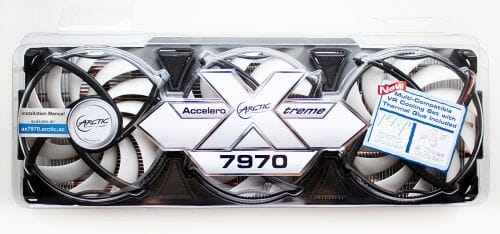
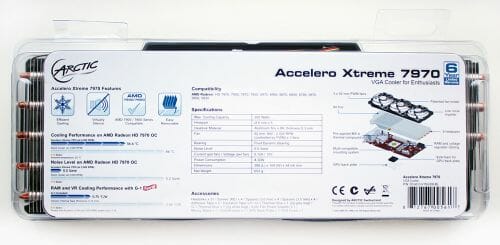
I have to admit all this sounds more than optimistic. But we are going to find out very soon whether it is indeed the case.
Despite the compact size of the cooler packaging, it also contains a lot of aluminum heatsinks for the video memory chips, two-step thermal glue kit, PATA-adapter, retention kit, meshed bracket for the back case panel, a backplate with soft padding and an ARCTIC logo sticker:
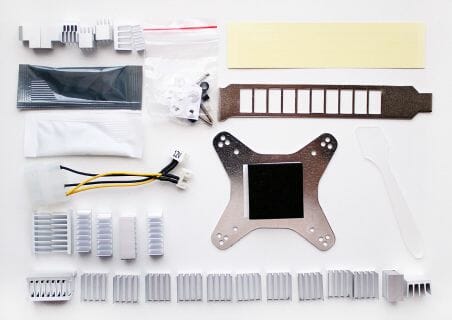
Arctic Accelero Xtreme 7970 is manufactures in China. It comes with 6-year warranty. The MSRP is pretty high, as usual, and is set at $97.95.
Design and Functionality
As we have already mentioned before, Accelero Xtreme 7970 doesn’t differ much from the previous cooler modifications. It is equipped with the same three 92-mm fans 10 mm thick that sit inside a plastic casing. This casing sits on top of two heatsink arrays on five copper heatpipes 6 mm in diameter going through the copper base plate:
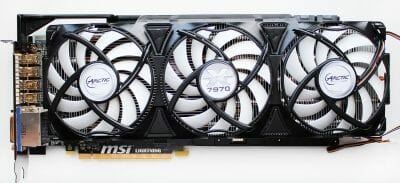
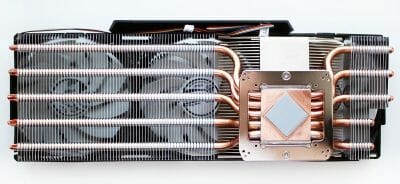
The cooler measures 288x104x54 mm and weighs 653 grams. According to the official specifications, Accelero Xtreme 7970 should be able to handle 300 W of peak thermal load, which is more than enough eve for the today’s most powerful graphics accelerators.
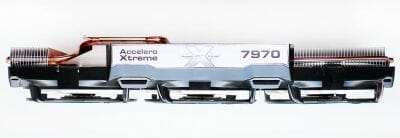
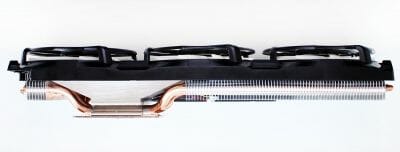
The heatsink consists of 77 aluminum fins (92×21 mm) and 7 fins (60×21 mm) that are pressed against the heatsinks at 1.8 mm intervals:
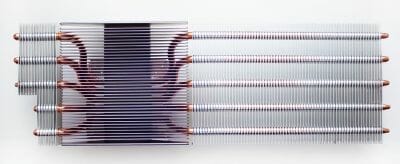
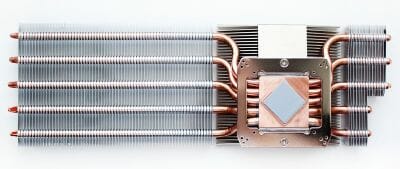
The fins thickness remained the same as before: 0.3 mm. the overall calculated effective heatsink surface also remained unchanged and equals 3,070 cm2. There is an additional aluminum heatsink (95×92 mm) right above the base plate, which removes the heat off the top of the heatpipes in the base plate area.
The heatpipes are evenly spread out in the base of the cooler at about 12-13 mm from one another. They lie inside special grooves and are soldered to them carefully:
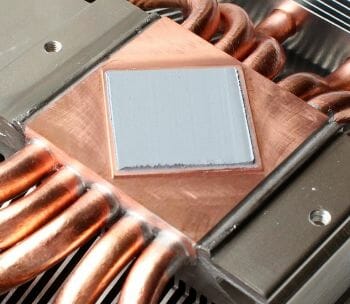
The main difference between the new Accelero Xtreme 7970 and its predecessors – is the raised square on the cooler base, which stands out by about 1 mm above the base surface. As you know, “Tahiti” die (AMD Radeon HD 7970 and HD 7950) sits a little below the protective metal frame that is why this raised square on the base will ensure proper contact between the GPU and the Accelero Xtreme 7970 cooler.
There is a layer of highly efficient Arctic MX-4 thermal paste (8.5 W/m*K thermal conductivity) already pre-applied to the base. However, it is way too thick that is why most of the thermal paste will be squeezed past the edges of the chip onto the GPU board:
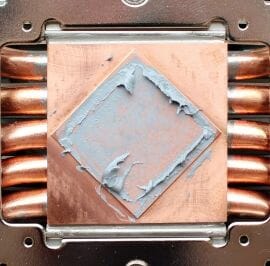
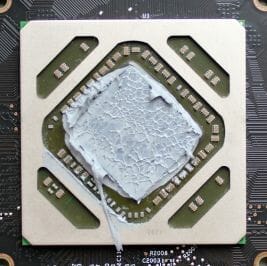
In my opinion, it would be way better to include a small pack of this paste with the cooler rather than apply a thick layer like that onto the base.
Accelero Xtreme 7970 has three 92-mm fans:
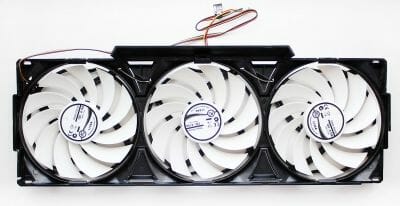
Their rotation speed can be adjusted using PWM method in the interval between 900 and 2000 RPM. The minima noise, which they measure in Sones, is claimed to be 0.5 Sone. The fluid-dynamic bearing inside the fans should last at least 6 years, and each fan should consume no more than 1.44 W (4.32 W for all three fans).
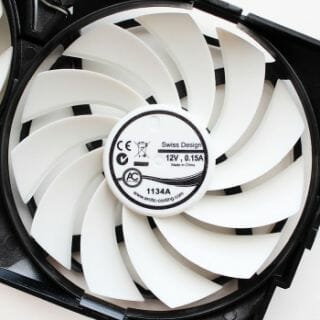
According to our tests, all fans consumed no more than 2.7 W of power. They can be connected to four- as well as three-pin power-connectors on the graphics card, or directly to the PATA connectors on the PSU using the enclosed PATA adapter.
Compatibility and Installation
Despite the Accelero Xtreme 7970 model name, the new cooler is compatible not only with the Radeon HD 7970, but also with AMD Radeon HD 7950, HD 7850, HD 7850, HD 6970, HD 6950, HD 6870, HD 6850, HD 6790, HD 5870, HD 5850, HD 5830. In order to determine if the cooler is compatible with a specific graphics card, Arctic offers two detailed schematics on their company web-sites with all cooler dimensions:
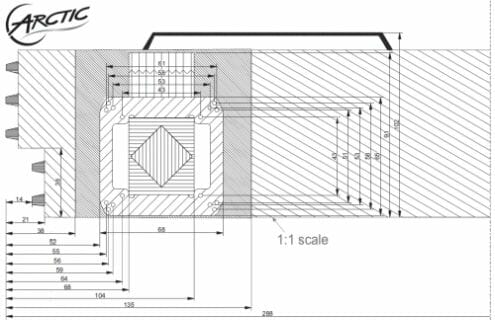
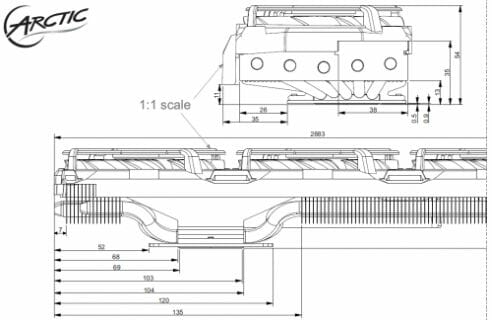
They will show definitively if Accelero Xtreme 7970 will or will not fit onto a given graphics card.
The actual installation procedure is described in detail in the following manual and starts with dismounting of the default cooler. For our today’s test session e selected MSI R7970 Lightning graphics card with the original Twin Frozr IV cooling system:
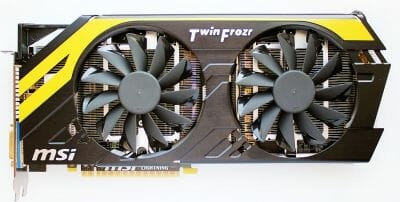
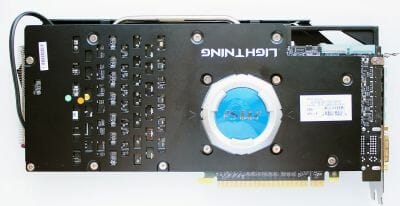
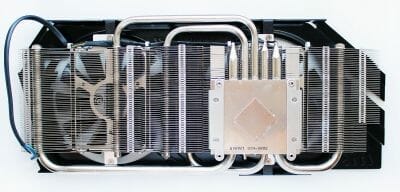
Testing graphics card coolers on a unique platform like this has a lot of advantages. Namely, this platform has enhanced voltage regulator circuitry and boasts increased overclocking potential. On top of that it is also possible to monitor the temperature of the VRM components and video memory chips, besides the actual GPU temperature. This will allow us to fully investigate the efficiency of the graphics cards coolers in general, and Accelero Xtreme 7970 in particular.
Moreover, a solid heat-spreader plate will allow us to do without the included aluminum heatsinks:
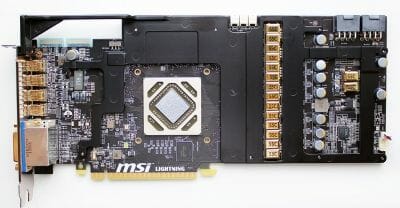
We had to remove the “GPU Reactor” stabilization module on the back of the card in order to attach the bundled backplate:
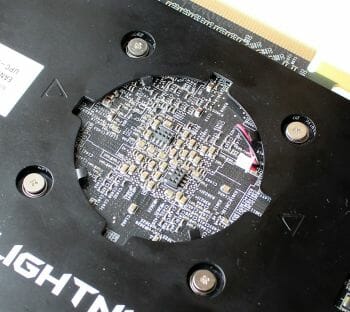
Luckily, it didn’t affect graphics card stability at higher clock speeds. Now we can put the padded backplate in place:
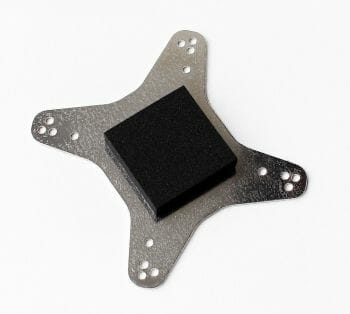
To avoid any possible backplate shifting during installation, we use plastic stick-on bushes on the inside. They also ensure that the plate gets evenly pressed against the card on all sides:
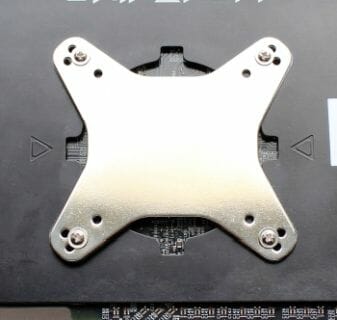
Once the cooler has been installed onto the graphics card, it looks even more massive and promising than with MSI’s proprietary Twin Frozr IV cooler:
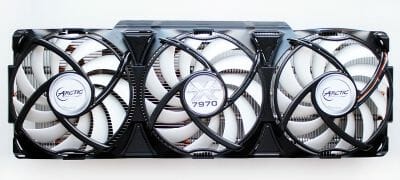
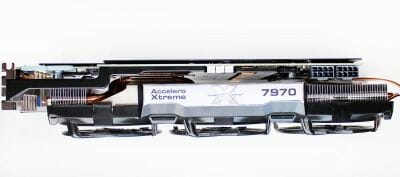
The card with Accelero Xtreme 7970 installed will block two PCI slots next to it and will become 35 mm longer:
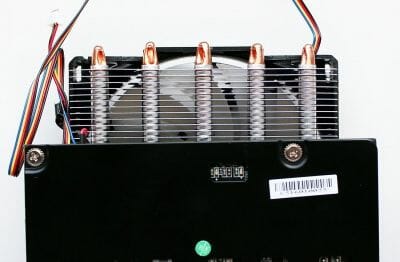
Note that Arctic Accelero Xtreme 7970 is 288 mm long.
At the same time, I would like to mention that the cooler doesn’t block the access to additional power connectors, which is often the case with many alternative VGA coolers:
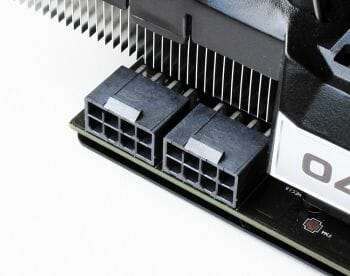
Technical Specifications and Recommended Pricing
Testbed and Methods
The tests were performed in a closed system case. Our testbed was configured as follows:
- Mainboard: Intel Siler DX79SI (Intel X79 Express, LGA 2011, BIOS 0494 from 04/24/2012);
- CPU: Intel Core i7-3960X Extreme Edition, 3.3 GHz, 1.2 V, 6 x 256 KB L2, 15 MB L3 (Sandy Bridge-E, C1, 1.2 V, 6×256 KB L2, 15 MB L3);
- CPU cooler: Phanteks PH-TC14PE (2 135 mm, 900 RPM);
- Thermal interface: ARCTIC MX-4;
- System memory: DDR3 4 x 4GB Mushkin Redline (Spec: 2133 MHz / 9-11-10-28 / 1.65 V);
- Graphics card: MSI R7970 Lightning 31 GB/384 bit GDDR5, 1140/7160;
- System drive: Crucial m4 256 GB SSD (SATA-III,CT256M4SSD2, BIOS v0009);
- Drive for programs and games: Western Digital VelociRaptor (300GB, SATA-II, 10000 RPM, 16MB cache, NCQ) inside Scythe Quiet Drive 3.5” HDD silencer and cooler;
- Backup drive: Samsung Ecogreen F4 HD204UI (SATA-II, 2 TB, 5400 RPM, 32 MB, NCQ);
- System case: Antec Twelve Hundred (front panel: three Noiseblocker NB-Multiframe S-Series MF12-S2 fans at 1020 RPM; back panel: two Noiseblocker NB-BlackSilent PRO PL-1 fans at 1020 RPM; top panel: standard 200 mm fan at 400 RPM);
- Control and monitoring panel: Zalman ZM-MFC3;
- Power supply: Xigmatek “No Rules Power” NRP-HC1501 1500 W (with a default 140 mm fan);
- Monitor: Samsung S27A850D, 27”.
One of the available BIOS versions for MSI graphics card already has increased operational frequencies of 1070/5600 MHz. However, we decided to heat things up a little more and overclocked this graphics card even more – to 1140/7160 MHz:
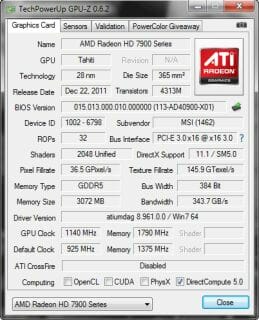
We are going to compare the cooling efficiency and acoustic performance of the new Arctic Accelero Xtreme 7970 against the default MSI Twin Frozr IV cooler.
The testing programs were installed under Microsoft Windows 7 Ultimate x64 SP1. We used DirectX End-User Runtimes libraries (from November 2010), as well as AMD Catalyst 12.4 graphics card drivers. We warmed up the card with five runs of Aliens vs. Predator game in 2560×1400 resolution and with maximum image quality settings, 16x anisotropic filtering and 4x antialiasing:
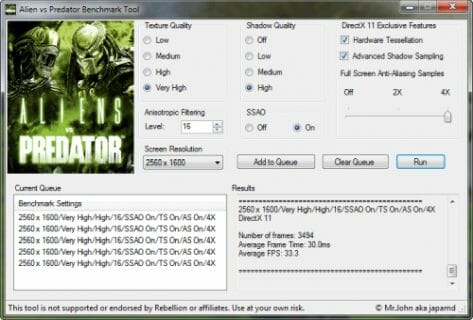
With the settings we used this test loads even a powerful graphics accelerator very heavily, but can’t damage it, which could be the case with FurMark (that is why we decided not to use this benchmark fully in our test session).
We used MSI Afterburner utility version 2.2.1 to monitor graphics card temperatures and frequencies and GPU-Z version 0.6.2 utility.
The tests were run at least twice. The temperature stabilization period between the two test cycles was about 10-12 minutes. The ambient temperature was checked next to the system case with an electronic thermometer with 0.1°C precision that allows monitoring the temperature changes over the past 6 hours. During our test session room temperature stayed around 24.8-25.3°C. We used our in-house controller to adjust the rotation speed of the fans.
The noise level of each cooler was measured between 1:00 and 3:00 AM in a closed room about 20 m2 big using CENTER-321 electronic noise meter. The noise level for each cooler was tested outside the system case when the only noise sources in the lab were the cooler and its fan. The noise meter was installed on a tripod and was always at a 150 mm distance from the cooler fan rotor. The tested cooling systems were placed at the edge of the desk on a sheet of polyurethane foam. The lowest noise reading our noise meter device can register is 29.8 dBA and the subjectively comfortable noise level in these testing conditions was around 36 dBA (do not mix it up with low noise level).
Performance
Cooling Efficiency
Let’s see, which if the two will be more efficient: MSI Twin Frozr IV or Arctic Accelero Xtreme 7970:
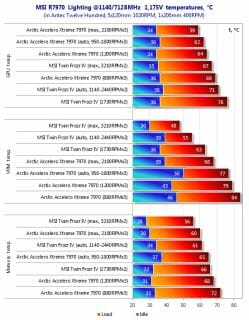
Let’s analyze the obtained results in all three aspects. In terms of GPU temperature, Arctic Accelero Xtreme 7970 is a definite leader. In quiet mode, when all three fans are rotating at 880 RPM, Accelero Xtreme 7970 is 7°C more efficient than Twin Frozr IV at 1730 RPM, and 4°C more efficient in auto mode at 1140-2440 RPM. Only at the maximum speed of 3210 RPM Twin Frozr IV manages to get 2°C ahead of Accelero Xtreme 7970 at the minimal 880 RPM. I believe I don’t have to tell you that the difference in noise in the latter case is simply colossal. As far as the faster fan modes of the new Accelero Xtreme 7970 are concerned, even a very efficiency cooling system from MSI can’t compete against the unbeatable Arctic product. The latter is still 2-7°C better than MSI Twin Frozr IV at its best.
In terms of the VRM components temperature the difference between the tested coolers is even more obvious, and remarkably, not in Arctic’s favor. The unique fans of the MSI Twin Frozr IV create higher static pressure. That as well as better positioning of the fans over the VRM components allows the competitor to cool VRM parts much better than Arctic Accelero Xtreme 7970 can do. While this is certainly important, it is not crucial, because VRM components on AMD Radeon HD 79xx graphics cards are famous for their ability to cope with high operational loads at 100°C+ temperatures, and the highest temperature in our case never exceeded 84°C.
Finally, the third group of results related to the video memory temperature, indicates a smaller difference between the opponents than with VRM components. In fact, it is similar to what we have just seen with the GPU temperatures. Both products cope quite well with video memory chips cooling, but in the end MSI Twin Frozt IV manages to get a little ahead of the Arctic Accelero Xtreme 7970.
While analyzing the cooling efficiency results, it is important to take into account the acoustic performance of both coolers. Let’s move on to that aspect.
Noise
The results of our acoustic measurements performance for Arctic Accelero Xtreme 7970 and MSI Twin Frozr IV coolers are summed up on the following graph:
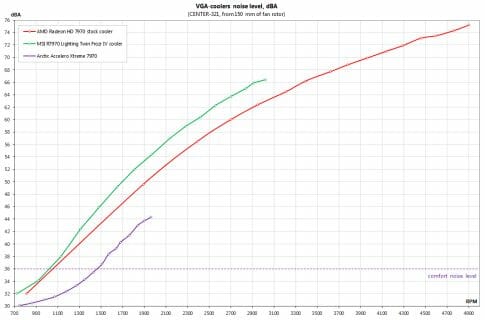
Arctic cooler once again proved to be exceptionally quiet remaining acoustically comfortable up to 1450 RPM, and practically inaudible up to 100 RPM. It is an absolute leader acoustic performance among all VGA coolers. However, MSI Twin Frozr IV cooler turned out more of a disappointment here: it proved to be even noisier than the reference AMD Radeon HD 7970 cooler, which is also quite noisy. Only due to lower minimal fan speeds Twin Frozr IV cooler outperformed the reference one in maximum noise level test, but it doesn’t save the day against the background of remarkable performance demonstrated by Arctic product. For example, when we tested MSI Twin Frozr IV with the fan rotation speed set manually to 1730 RPM, the noise was around 51 dBA. However, Arctic Accelero Xtreme 7970 generates no more than 45 dBA even with all three of its fans rotating at their maximum speed.
Conclusion
It is time to sum up a few things. Inside a closed system case Arctic Accelero Xtreme 7970 can cool a Radeon HD 7970 3 GB graphics card running at 1140/7128 MHz (1.175 V) with three fans rotating at 880 RPM and maintain its GPU temperature at 69°C, VRM temperature – at 84°C and video memory temperature – at 72°C. And most importantly, you won’t hear this cooler at all. Pretty impressive, isn’t it? This is what real extreme air-cooling for the fastest and most expensive graphics cards should look like! Arctic once again nailed it!
Speaking of the new Arctic Accelero Xtreme 7970, we really can’t come up with any shortcomings. A thick layer of thermal paste can hardly count as one, and the universal compatibility has never been promised anyway. If you are looking for a product that will be indeed universal, Arctic already has new Accelero Xtreme III, which we will review shortly. As for the high price of $98, well, blame the competitors who are still unable to design anything that will beat Accelero Xtreme 7970 in efficiency and noise.
In conclusion we are proud to award Arctic Accelero Xtreme 7970 with our Editor’s Choice title as the best VGA cooler for AMD Radeon HD 79xx products:
